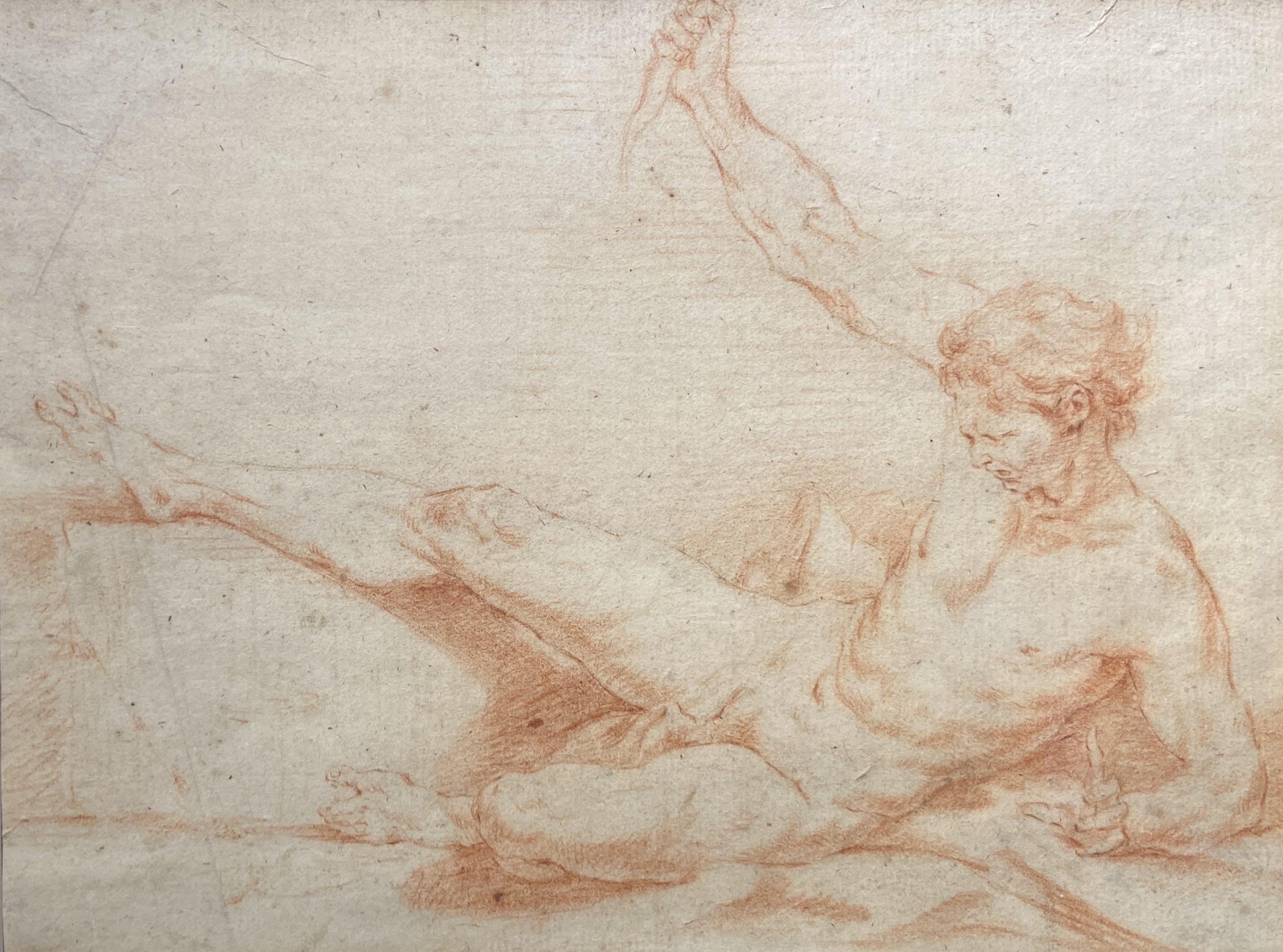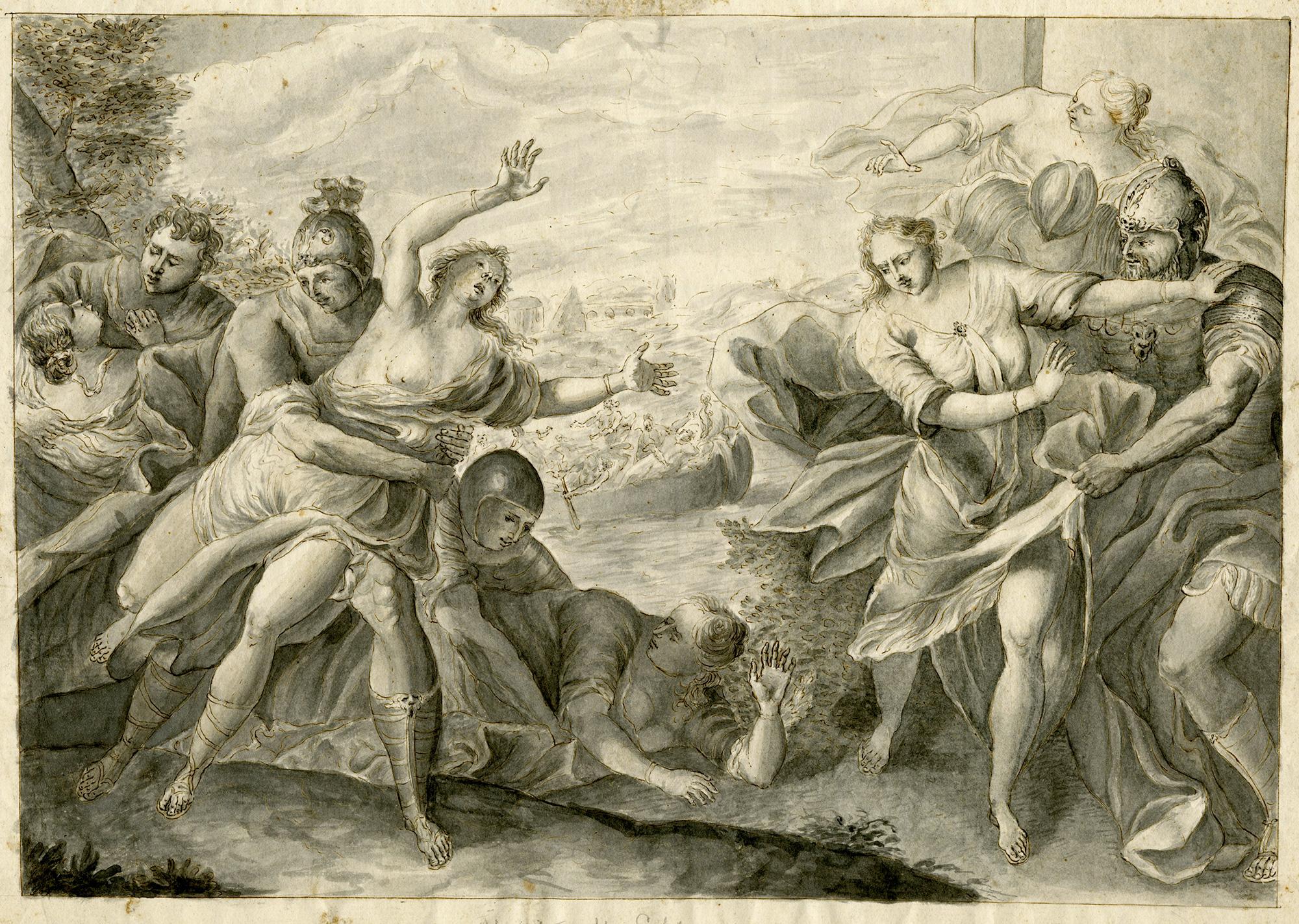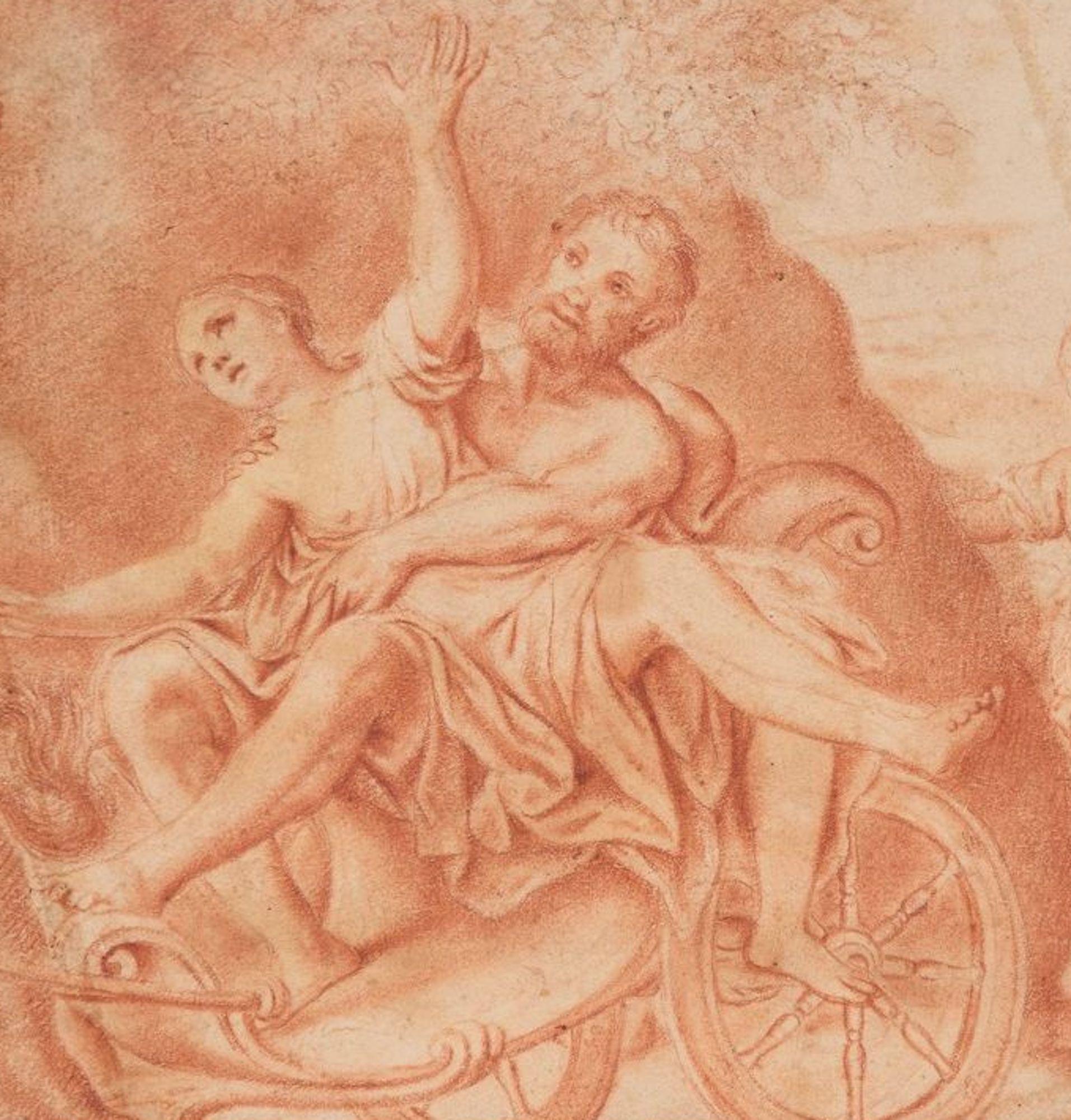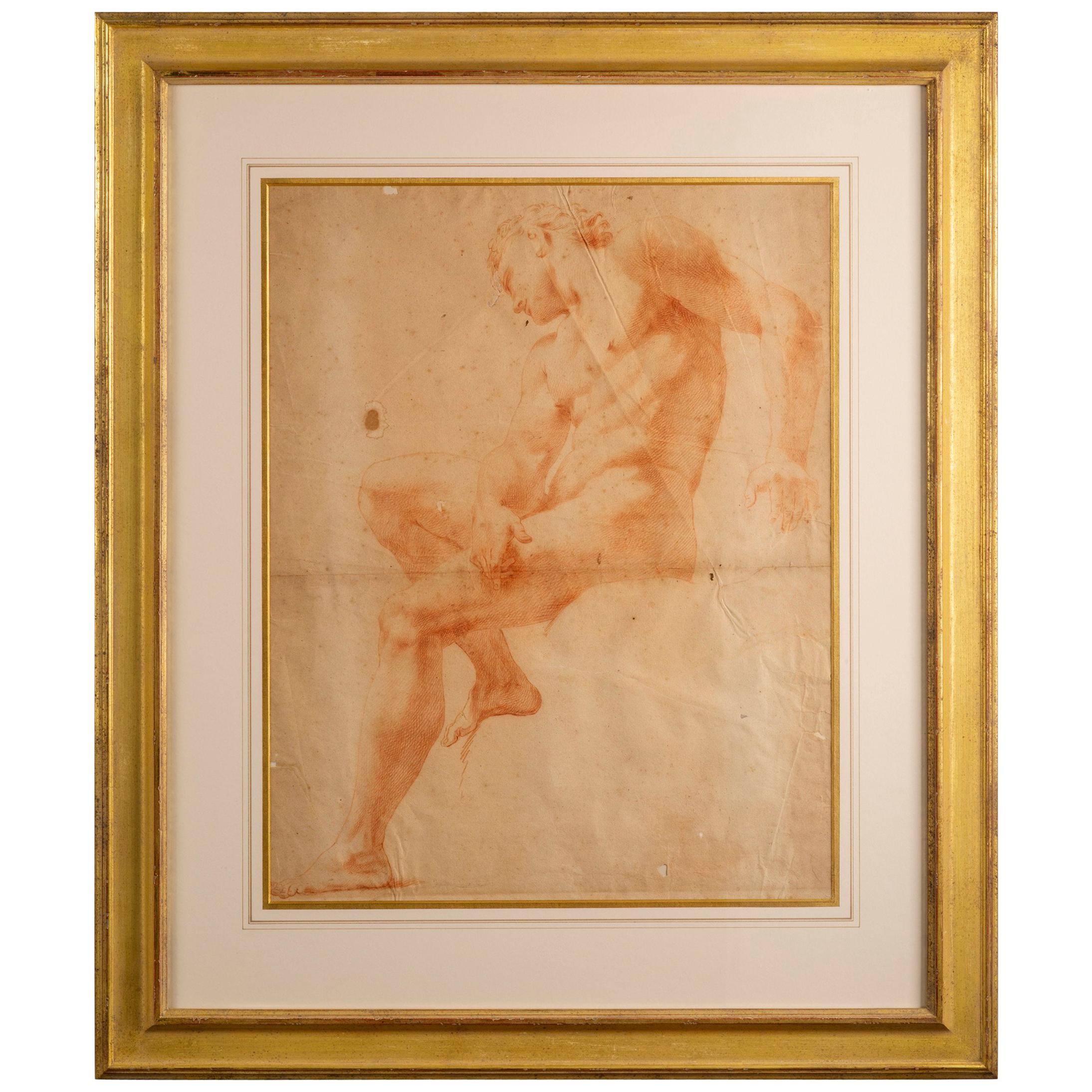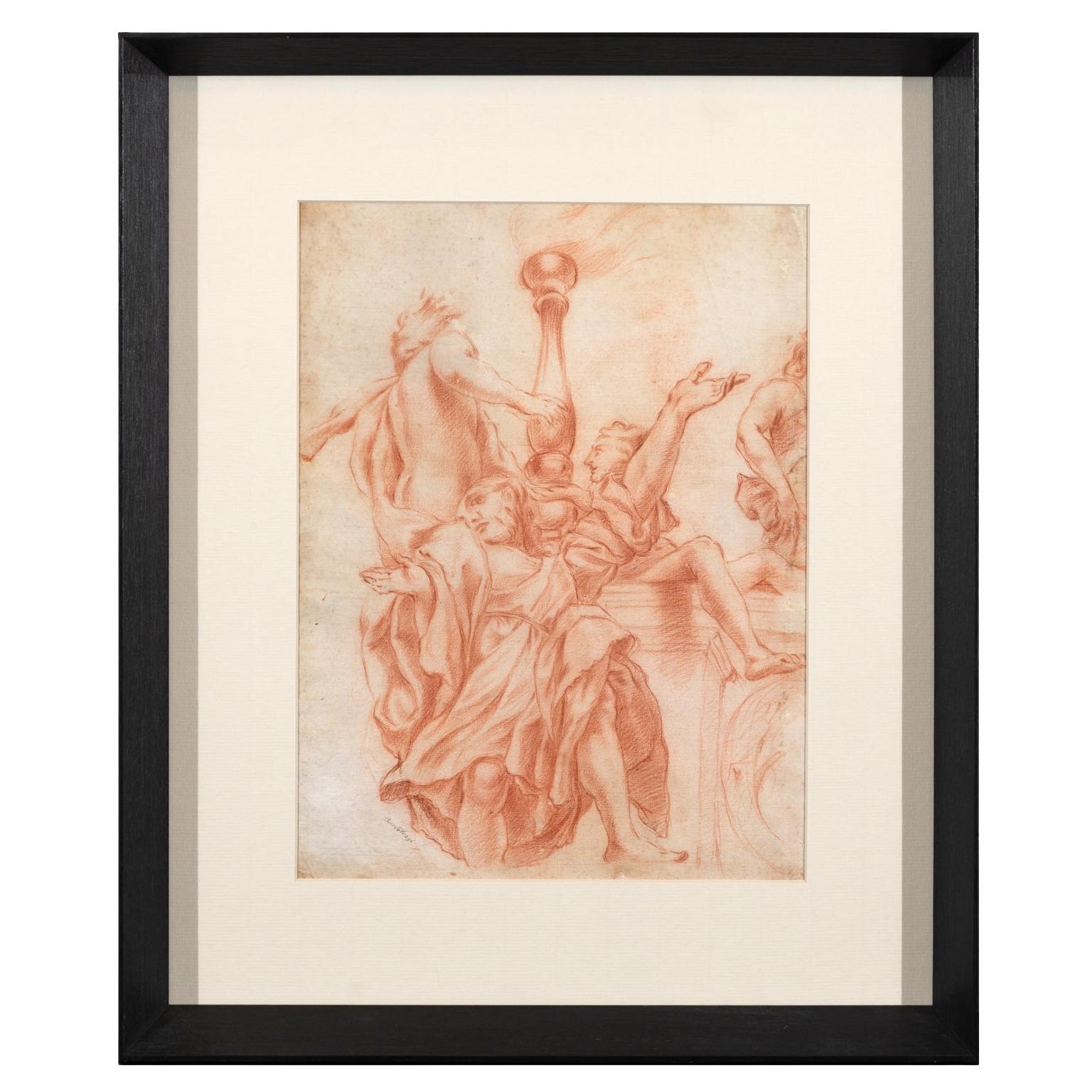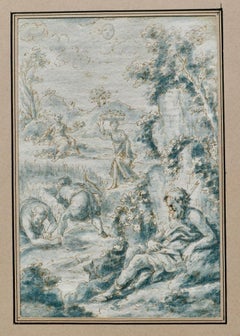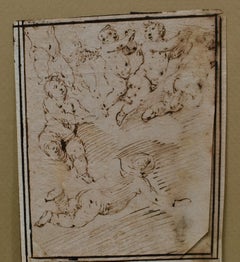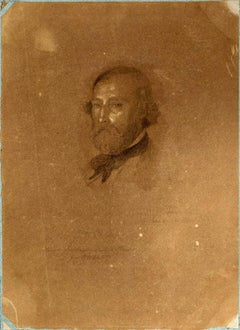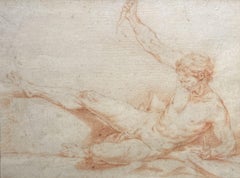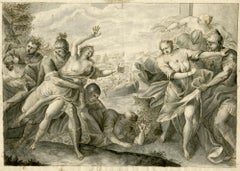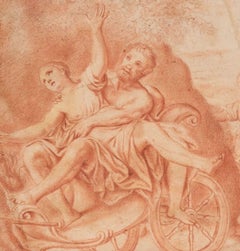Items Similar to Italian School 18th Century Drawing - Red Chalk on Paper
Want more images or videos?
Request additional images or videos from the seller
1 of 16
UnknownItalian School 18th Century Drawing - Red Chalk on Paper17th/18th century
17th/18th century
$2,142.29
£1,593.95
€1,800
CA$3,001.33
A$3,293.93
CHF 1,698.77
MX$39,348.35
NOK 21,526.58
SEK 20,171.41
DKK 13,711.47
About the Item
An Italian red chalk drawing depiction on paper, probably 17th or 18th century, illustrating the dramatic scene of Polyphemus hurling a boulder at Acis and Galatea. Attributed to an unidentified, probably Italian master, the composition portrays a narrative from ancient Greek mythology where the jealous giant cyclops Polyphemus, in a fit of rage, kills Acis by crushing him with a massive rock. This piece seems to draw inspiration from Annibale Carracci's renowned ceiling frescoes in the Palazzo Farnese, Rome, specifically the "Loves of the Gods" series painted circa 1597–1601. One particular fresco in this series depicts Polyphemus in the act of throwing a rock at Acis and Galatea, suggesting that the artist of this drawing may have been influenced by Carracci's interpretation. While there are notable differences, the compositional similarities indicate a study to the earlier masterpiece. Throughout the centuries, numerous artists visited the Farnese Gallery to study and draw inspiration from Carracci's work, underscoring its significant impact on subsequent art.
The subject matter derives from ancient Greek mythology, specifically the tale of Acis, Galatea, and Polyphemus, made famous through Ovid’s Metamorphoses. The Cyclops Polyphemus, a fearsome, one-eyed giant, is deeply in love with Galatea, a beautiful sea-nymph. However, Galatea’s affections lie with Acis, a handsome young mortal shepherd. Enraged by jealousy upon discovering the lovers together, Polyphemus unleashes his wrath by ripping a boulder from the earth and hurling it at Acis, fatally crushing him. Stricken with grief, Galatea transforms Acis's blood into a river spirit, thus granting him immortality.
The scene has been a powerful symbol in Western art and literature for centuries—portraying unrequited love, jealousy, and tragic loss. It has inspired countless works across time, from Roman frescoes to Baroque painting and Romantic poetry.
Annibale Carracci (1560–1609) was a pivotal figure in Italian Baroque painting. Born in Bologna, he, along with his brother Agostino and cousin Ludovico, founded the Carracci Academy, aiming to reform art by emphasizing naturalism and the study of classical models. Carracci's work is characterized by its harmonious composition, dynamic movement, and vivid depiction of human emotion. His frescoes in the Palazzo Farnese, particularly the "Loves of the Gods" series, are considered masterpieces that bridge the Renaissance and Baroque periods. Carracci's innovative approach and dedication to blending classical traditions with contemporary techniques significantly influenced the trajectory of European art.
- Creation Year:17th/18th century
- Dimensions:Height: 14.18 in (36 cm)Width: 20.48 in (52 cm)Depth: 0.4 in (1 cm)
- Medium:
- Movement & Style:
- Period:
- Condition:Paper laid on paper. Older restoration to lower edge parts and possibly some trimming at lower bottom. Some minor staining but otherwise in seemingly good condition. Presently mounted in a passepartout.
- Gallery Location:Stockholm, SE
- Reference Number:1stDibs: LU2608216083102
About the Seller
5.0
Platinum Seller
Premium sellers with a 4.7+ rating and 24-hour response times
1stDibs seller since 2023
28 sales on 1stDibs
Typical response time: <1 hour
- ShippingRetrieving quote...Shipping from: Stockholm, Sweden
- Return Policy
Authenticity Guarantee
In the unlikely event there’s an issue with an item’s authenticity, contact us within 1 year for a full refund. DetailsMoney-Back Guarantee
If your item is not as described, is damaged in transit, or does not arrive, contact us within 7 days for a full refund. Details24-Hour Cancellation
You have a 24-hour grace period in which to reconsider your purchase, with no questions asked.Vetted Professional Sellers
Our world-class sellers must adhere to strict standards for service and quality, maintaining the integrity of our listings.Price-Match Guarantee
If you find that a seller listed the same item for a lower price elsewhere, we’ll match it.Trusted Global Delivery
Our best-in-class carrier network provides specialized shipping options worldwide, including custom delivery.More From This Seller
View AllAllegory of Summer - 17th Century Italian Sepia and Watercolor Drawing
Located in Stockholm, SE
A fine Italian watercolor and sepia drawing, an allegory of summer. People harvesting, eating and drinking in a hilly landscape, probably by Antonio Grano (c.1669-1718). In the fron...
Category
Late 17th Century Italian School Figurative Drawings and Watercolors
Materials
Paper, Ink, Watercolor
Italian School 17th Century Drawing of Putti
Located in Stockholm, SE
A fine small Italian 17th/18th century sepia ink study of 6 putti in different positions. Paper mounted on paper. A tergo written "Scuola Lombarda".
A putto/putti are figure in a wo...
Category
17th Century Italian School Figurative Drawings and Watercolors
Materials
Ink
Italian Capriccio with Ruins Venice - 18th Century Oil on Canvas
By Gaetano Vetturali (Lucca, 1701-1783)
Located in Stockholm, SE
A Venetian capriccio view with classical architectural ruins and in the background the church of San Giorgio Maggiore and the Church of Santa Maria della Salute next to the Grand Can...
Category
1770s Old Masters Landscape Paintings
Materials
Canvas, Oil
Portrait Gustav Wilhelm Palm - 19th Century Pencil and Pastel on Paper
Located in Stockholm, SE
Portrait of Gustaf Wilhelm Palm (1810–1890) by Lorenz Frølich (1820-1908)
Signed with monogram and dated May 1849. Pencil and pastel on paper. 29.5 × 21 cm.
This portrait of the Swed...
Category
1840s Naturalistic Portrait Drawings and Watercolors
Materials
Paper, Pastel, Carbon Pencil
Cloud Study - 19th Century Oil on Paper
Located in Stockholm, SE
Cloud study by a rocky coastline overlooking the sea. To the right of the composition stands a large maritime marker, while in the lower left a few ship masts emerge in the distance....
Category
19th Century Other Art Style Landscape Paintings
Materials
Paper, Oil, Wood Panel
Kitchen Scene - 18th Century Oil on Panel
By Jan Baptist Lambrechts
Located in Stockholm, SE
A Kitchen Scene by Jan Baptist Lambrechts (Antwerp, 1680–1731)
The painting depicts a lively kitchen interior where a man, wearing a hat, raises a glass of red wine in a toast toward...
Category
Early 18th Century Flemish School Figurative Paintings
Materials
Oil, Wood Panel
You May Also Like
The Death of Attis, 18th Century French Red Chalk Drawing, Greek Mythology
Located in London, GB
Red chalk on paper
Image size: 9 x 7 inches (23 x 17.75 cm)
Acid free mount
The Greek god Attis was the spouse of Cybele, the fertility goddess. He was from Phrygia, a kingdom in c...
Category
18th Century French School Figurative Drawings and Watercolors
Materials
Chalk
Old Masters Chalk Drawing, 17th Century Italian Sanguine on Paper
Located in London, GB
Sanguine chalk on paper
Image size: 7 x 8 1/2 inches (18 x 22 cm)
Acid free cut-out mount
This 17th century drawing depicts a reclining woman with her back.
The Sanguine chalk that...
Category
17th Century Italian School Figurative Drawings and Watercolors
Materials
Paper, Chalk
Il Ratto della Sabine – Italian School 18th century
Located in Middletown, NY
An intense scene of an incident in the legendary history of Rome.
Italian School 18th century, circa 1700.
Ink and wash in brown and grayish black ink on cream laid paper, 12 1/8 x...
Category
Late 18th Century Italian School Figurative Drawings and Watercolors
Materials
Watercolor, Laid Paper, Ink, Graphite, Handmade Paper
Rape of the Sabines - Sanguine Drawing End of 18th Century
Located in Roma, IT
Rat of Sabinesis an original sanguine drawing on thick cream-colored paper, realized by an anonymous French artist of the end of XVIII century.
A superb original drawing with skille...
Category
Late 18th Century Figurative Drawings and Watercolors
Materials
Pastel
Large Red Chalk Drawing, 18th Century Italian School
Located in Kittery Point, ME
Nude male academy.
Red chalk on paper.
While the artist who drew this drawing is not known, the confidence in the trait along with the fascinating perspect...
Category
Antique Mid-18th Century Italian Rococo Drawings
Materials
Paper
Francesco Bartolozzi (1727–1815) — Red Chalk Drawing, 18th Century
Located in Lisboa, PT
Francesco Bartolozzi (1727–1815) — Red Chalk Drawing, 18th Century
Medium: Red chalk on paper
Artist: Francesco Bartolozzi (attr.)
Origin: Italy, 18th Century
Frame Dimensions: App...
Category
Antique Late 18th Century Portuguese Drawings
Materials
Paper
More Ways To Browse
Italian Baroque Painting
Annibale Carracci
Drawings Italian 18th Century
Red Chalk Drawing
Roman Baroque Painting
Wpa Art Charles
18th Century Charcoal Drawing
Abraham Manievich
Abram Lerner
Amado M Pena Jr
Andrzej Szypluk
Bain De Soleil
Barbara Nessim
Cyclops Painting
Eduardo Esquivel
French Dress Sketches
Georges Clairin
Gibson Girl Vintage
